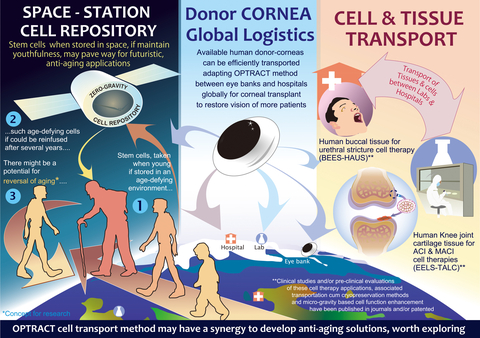东京

(美国商业资讯)–日本科学家开发出一种人类尸体供体角膜的高效运输方法,有望增加供应量,给数百万等待角膜移植以恢复视力的角膜盲症患者带来福音。OPTRACT方法能逆转细胞老化,从而在医院和实验室间的运输途中更好地保存人类口腔组织和软骨。此外,该方法还获得了在微重力下增强免疫细胞功能的日本专利。研究人员认为,这些成就预示着一项未来的战略行动,即在没有重力的空间站上评估星际环境对人类细胞的影响,如果能抵御与衰老有关的损害,可能会产生对抗衰老的解决方案。
本新闻稿包含多媒体。此处查看新闻稿全文: https://www.businesswire.com/news/home/20220302006161/zh-CN/

A cell repository aboard a space station in zero gravity or in a micro gravity of other planets or inter-stellar space, in which, if aging related implications or damages to cells could be alleviated, storing human stem cells for certain duration, with suitable gravitational forces and then re-infusion, might yield restoration of youth. Accomplishments by OPTRACT method-based transportation of cells and tissues between hospitals and laboratories for regenerative medicine – cell therapy applications, human cadaver corneal transportation across destinations and cryopreservation of stem cells; several published by the Japanese scientists and granted patents, have paved way to these futuristic research strategies of space-age anti-aging solutions. The OPTRACT method based in vitro culture has yielded reversal of senescence of human chondrocytes in the lab, employing proprietary tissue engineering techniques. (Graphic: Business Wire)
再生医学中的细胞疗法涉及在医院采集组织、运送到细胞处理设施、分离和培养细胞、保存不同的时长,直至移植给患者。
具有跨学科专长的科学家使用化学合成的聚合物支架完成了以下开创性的解决方案:
- 人类尸体供体角膜运输。可更好地保存角膜内皮细胞密度:https://doi.org/10.1007/s10529-021-03116-y
- 用于治疗男性尿道狭窄的人类口腔粘膜的保存和运输:https://doi.org/10.1089/bio.2021.0079
- 用于自体细胞软骨移植(ACI)和基质诱导的自体软骨细胞移植(MACI)疗法的软骨运输,以治疗膝关节损伤:https://doi.org/10.1016/j.jor.2022.01.007
- 无冷链角膜内皮物流运输 (https://pubmed.ncbi.nlm.nih.gov/24008800/)和大泡性角膜病治疗:https://www.ncbi.nlm.nih.gov/pmc/articles/PMC5840311/
- 增强一氧化氮的微重力。协助免疫细胞消灭癌症的武器:日本专利:6757578/2020
- 骨髓和脐带血干细胞的冷冻保存:日本专利:6373241/2018
科学家已在实验室中体外不同温度下验证了人类细胞和组织的表型维持、更高的活性、增强的自然杀伤细胞和逆转的细胞衰老(https://doi.org/10.1038/s41598-021-93607-9)。他们随之设想在空间站的零重力环境中研究细胞生物学和表观遗传学。他们提出,细胞可以运输和储存至空间站,如果证明这种环境可以延缓衰老,可能会获得有关抗衰老解决方案的线索。
江户川医院院长Shojiro Katoh博士对此满怀希望,他评论道:“现在,与志同道合的机构合作,在空间站上开启细胞储存梦想项目的时机已经成熟。这可能预示着一种新型的太空时代抗衰老药物的诞生。他的合作者们高度赞扬了日本支持创新解决方案开发的健全生态系统、该系统与GN公司全球网络和跨学专长的协同增效作用,以及来自JBM Inc.的大力支持。
https://sponsored.bloomberg.com/article/jco/japan-where-high-tech-meets-high-value-foreign-direct-investment
免责声明:本公告之原文版本乃官方授权版本。译文仅供方便了解之用,烦请参照原文,原文版本乃唯一具法律效力之版本。
在 businesswire.com 上查看源版本新闻稿: https://www.businesswire.com/news/home/20220302006161/zh-CN/
CONTACT
Samuel JK Abraham
info@gncorporation.com





